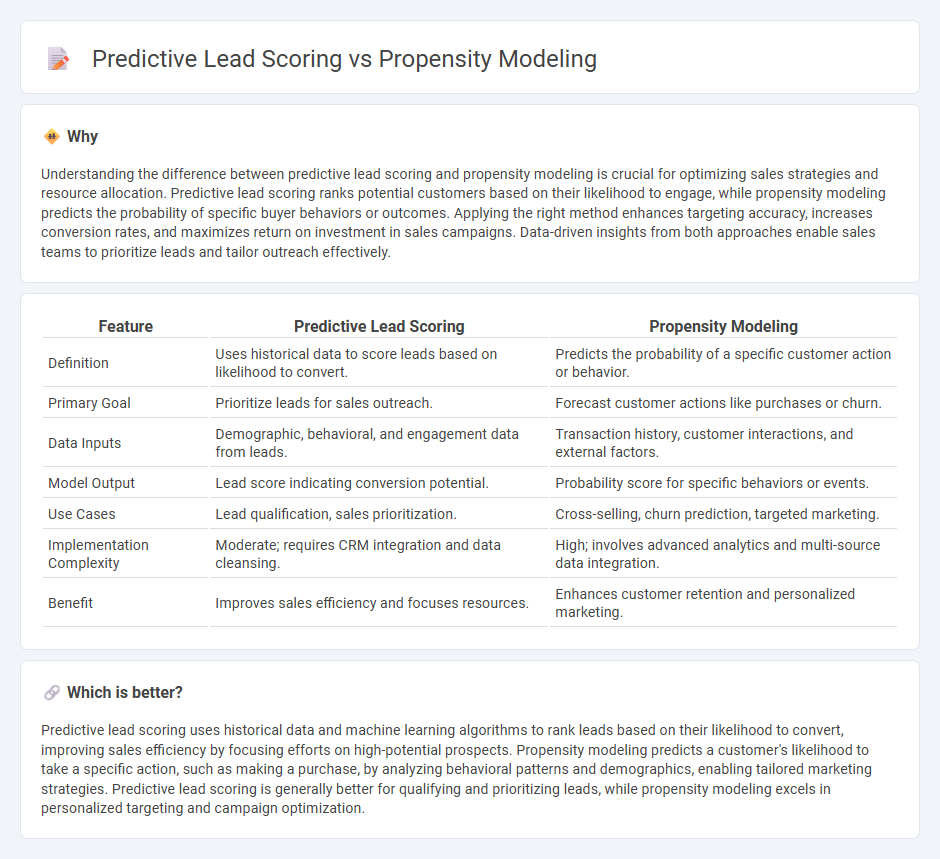
Predictive lead scoring uses historical data and machine learning algorithms to rank prospects based on their likelihood to convert, enhancing targeted sales efforts. Propensity modeling predicts the probability of a prospect performing a specific action, such as purchasing, by analyzing behavior patterns and demographic data. Explore the key differences and benefits of each approach to optimize your sales strategy.
Why it is important
Understanding the difference between predictive lead scoring and propensity modeling is crucial for optimizing sales strategies and resource allocation. Predictive lead scoring ranks potential customers based on their likelihood to engage, while propensity modeling predicts the probability of specific buyer behaviors or outcomes. Applying the right method enhances targeting accuracy, increases conversion rates, and maximizes return on investment in sales campaigns. Data-driven insights from both approaches enable sales teams to prioritize leads and tailor outreach effectively.
Comparison Table
| Feature | Predictive Lead Scoring | Propensity Modeling |
|---|---|---|
| Definition | Uses historical data to score leads based on likelihood to convert. | Predicts the probability of a specific customer action or behavior. |
| Primary Goal | Prioritize leads for sales outreach. | Forecast customer actions like purchases or churn. |
| Data Inputs | Demographic, behavioral, and engagement data from leads. | Transaction history, customer interactions, and external factors. |
| Model Output | Lead score indicating conversion potential. | Probability score for specific behaviors or events. |
| Use Cases | Lead qualification, sales prioritization. | Cross-selling, churn prediction, targeted marketing. |
| Implementation Complexity | Moderate; requires CRM integration and data cleansing. | High; involves advanced analytics and multi-source data integration. |
| Benefit | Improves sales efficiency and focuses resources. | Enhances customer retention and personalized marketing. |
Which is better?
Predictive lead scoring uses historical data and machine learning algorithms to rank leads based on their likelihood to convert, improving sales efficiency by focusing efforts on high-potential prospects. Propensity modeling predicts a customer's likelihood to take a specific action, such as making a purchase, by analyzing behavioral patterns and demographics, enabling tailored marketing strategies. Predictive lead scoring is generally better for qualifying and prioritizing leads, while propensity modeling excels in personalized targeting and campaign optimization.
Connection
Predictive lead scoring utilizes machine learning algorithms to analyze historical customer data and identify patterns that indicate the likelihood of a lead converting into a sale. Propensity modeling supports this process by estimating the probability that a specific lead will perform a desired action, such as purchasing a product, based on various behavioral and demographic factors. Together, these techniques enable sales teams to prioritize high-value prospects, improving lead management efficiency and increasing conversion rates.
Key Terms
**Propensity Modeling:**
Propensity modeling uses historical customer data and machine learning algorithms to estimate the likelihood of a specific action, such as purchase or churn, enhancing targeted marketing efforts. It focuses on predicting individual behavior by analyzing patterns and key variables, improving the accuracy of customer segmentation and campaign personalization. Explore how propensity modeling can refine your marketing strategy and boost conversion rates.
Probability Score
Propensity modeling and predictive lead scoring both utilize probability scores to estimate the likelihood of a prospect's future behavior, with propensity modeling focusing on the chance of an event occurring, such as purchase intent. Predictive lead scoring uses these probability scores to rank leads based on their potential to convert, optimizing sales and marketing efforts by prioritizing high-probability contacts. Explore further to understand how integrating these approaches can enhance customer acquisition and retention strategies.
Behavioral Signals
Propensity modeling leverages behavioral signals to estimate the likelihood of a customer taking a specific action, while predictive lead scoring uses these signals to rank potential leads based on their conversion probability. Behavioral data such as website interactions, email engagement, and social media activity are critical inputs for both approaches, enhancing accuracy in targeting high-value prospects. Explore how integrating behavioral signals can boost your marketing ROI and sales efficiency.
Source and External Links
An introduction to propensity modeling - Proove Intelligence - Propensity modeling uses statistical methods to predict the likelihood of user actions by analyzing behaviors and outcomes, assisting in optimizing experiences like increasing sales through targeted content exposure.
Propensity Modelling: Definition, types and use cases | Impression - Propensity modeling is a marketing tool that predicts customer actions using various techniques like logistic regression, decision trees, or neural networks, selecting features such as user behavior and demographics to tailor predictions.
Propensity Modeling - Netcore Cloud - Propensity modeling applies statistical and machine learning algorithms to score customers based on the probability of actions like purchasing or churn, enabling improved targeting, campaign efficiency, and personalized marketing.
 dowidth.com
dowidth.com